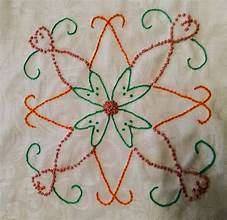Embroidery, a timeless craft that transcends cultures and generations, is an art form that has been woven into the fabric of human history for centuries. From delicate hand-stitched designs to intricate machine-made patterns, embroidered is a celebration of creativity, skill, and the beauty of craftsmanship. In this blog, we will delve into the enchanting world of embroidery, exploring its rich history, diverse techniques, and the captivating stories stitched into every thread.
The History of Embroidery: Embroidery has a storied past that dates back to ancient times. From the intricate silk threads of Chinese embroidery to the vibrant hues of Indian needlework, cultures around the world have embraced this art form as a means of expression, communication, and ornamentation. In medieval Europe, skilled artisans adorned the garments of royalty and clergy with elaborate embroidery, transforming simple fabrics into works of art. Over the centuries, embroidery has evolved, influenced by changing styles, technologies, and cultural movements.
The Craftsmanship Behind Embroidery: At its core, embroidery is a meticulous craft that demands patience, precision, and a keen eye for detail. Whether it’s the artful placement of stitches in traditional hand embroidery or the complex programming of a computerized embroidery machine, each piece is a testament to the skill and dedication of the artisan. Embroidery involves a variety of stitches, from the basic running stitch to the elaborate satin stitch and French knot, each contributing to the texture and visual appeal of the final piece.
Diverse Techniques in Embroidery: Embroidery is a versatile art form with a multitude of techniques, each offering a unique aesthetic. Cross-stitch, known for its simple yet striking geometric patterns, has been a popular choice for creating intricate designs on fabric. Crewel embroidery, characterized by wool threads on a linen background, has a rich history in English needlework. Additionally, contemporary techniques like machine embroidery have revolutionized the craft, allowing for intricate and large-scale designs with efficiency and precision.
The Art of Storytelling through Thread: Embroidery goes beyond the mere embellishment of fabric; it is a powerful means of storytelling. Many cultures have used embroidered textiles to convey narratives, myths, and historical events. Through carefully chosen symbols, colors, and motifs, artisans can communicate emotions, traditions, and personal experiences. From the narrative scenes depicted in Bayeux Tapestry to the symbolic storytelling in Palestinian tatreez, embroidery has been a medium for preserving cultural heritage and expressing individual creativity.
Embroidery in Modern Fashion and Art: In the contemporary world, embroidery continues to captivate and inspire. Fashion designers incorporate embroidered elements into their creations, adding a touch of handmade artistry to garments. Artists, too, use embroidery as a medium for self-expression, pushing the boundaries of traditional techniques to create thought-provoking and visually stunning works of art. Embroidery workshops and online communities provide platforms for enthusiasts to share their passion, learn new skills, and connect with like-minded individuals.
